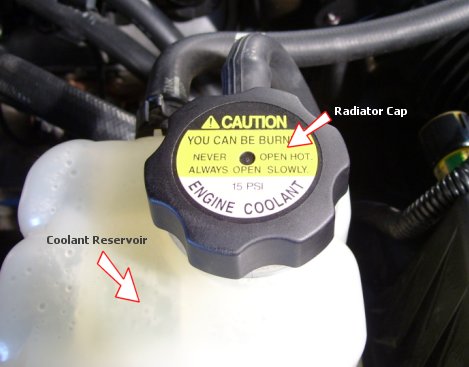Coolant Leak Detection
How To Inspect Coolant Leak
Engine Coolant Leak Fix
Helpful Information
Many points in a cooling system are able to develop leaks. Understanding the main physical components of the system helps. A leak in the heater core most often results in coolant on the front passenger-side floor. Most automobile antifreezes are either green, red, blue or yellow which are very toxic. Care must be taken when disposing of old coolant, the sweet odor can attract children and pets.
When removing the old hoses be careful to not apply excess force to fragile components such as the radiator and heater core. Often cutting old coolant hoses vertically along the connection helps in the removal process.
Best Practices
To avoid cooling system problems change engine coolant on a regular basis (30k to 40k) to avoid a chemical decomposition which will create an acid that attaches cooling system components and gaskets. Visit - Engine coolant service, Visit -Coolant information
Always check coolant level when the vehicle is cold.
When checking coolant hoses for replacement, squeeze each hose firmly, they should feel soft and flexible. If hoses are brittle or cracking replacement is recommended.
Inspect hoses or irregular bulges which are signs of a potential failure.
Step by step guide on how to find and repair an engine coolant leak. This article pertains to all vehicles other then electric.
Difficulty Scale: 4 of 10
Tools and Supplies Needed
Step 1 - To confirm an engine coolant leak inspect reservoir tank, if the reservoir is empty the cooling system probably has a leak. Always check the coolant level when the engine is cold.

Radiator Cap and Coolant Reservoir
Step 2 - Some times by simple inspection a coolant can be discovered using a flashlight to go over all key points such as the radiator, water pump, hoses, heater control valve and heater core.

Radiator Coolant Leak
Step 3 - If no coolant leaks are easily apparent a radiator pressure tester is needed. This device is securely held into the radiator cap inlet port while allowing a pressure pump to fill the system with pressure to help force the leak into view.
Step 4 - Once this inspection is complete and still no leaks are found, remove the oil fill cap to check for a blown head gasket. This is done by inspecting the oil inside the cap for a yellowish colored goop. Next, remove the oil dipstick to and inspect the integrity of the motor oil. If this oil is white or yellow coolant is leaking internally into the engine, in this case disassembly is required.
 Step 5 - Next, the car heater core must be inspected; the quickest way to check theheater core condition without removal the heater core is to inspect the passenger's side foot well compartment carpet for the presences of coolant. If coolant is present the heater core has failed and must be replaced or repaired. After necessary repairs have been made refill the cooling system with manufacturers recommended engine coolant and recheck operation.
Step 5 - Next, the car heater core must be inspected; the quickest way to check theheater core condition without removal the heater core is to inspect the passenger's side foot well compartment carpet for the presences of coolant. If coolant is present the heater core has failed and must be replaced or repaired. After necessary repairs have been made refill the cooling system with manufacturers recommended engine coolant and recheck operation.
- Flashlight
- Screwdriver set
- Wrench set
- Protective eyewear and gloves.
- Fluid catch basin

Radiator Cap and Coolant Reservoir
Step 2 - Some times by simple inspection a coolant can be discovered using a flashlight to go over all key points such as the radiator, water pump, hoses, heater control valve and heater core.

Radiator Coolant Leak

Comments
Post a Comment